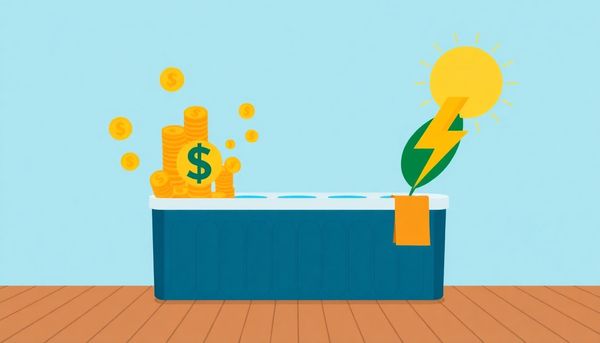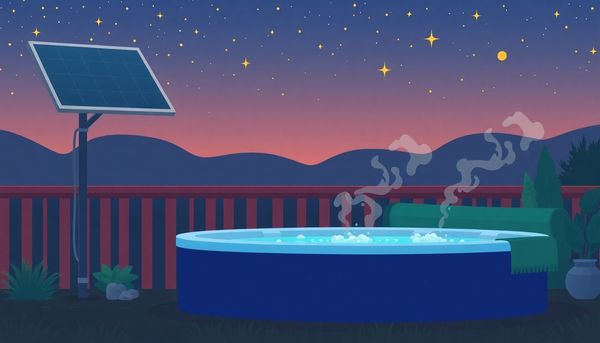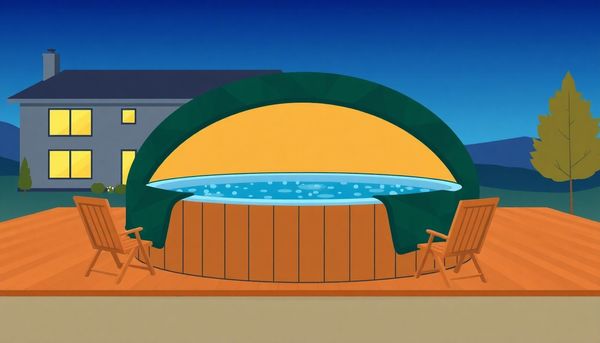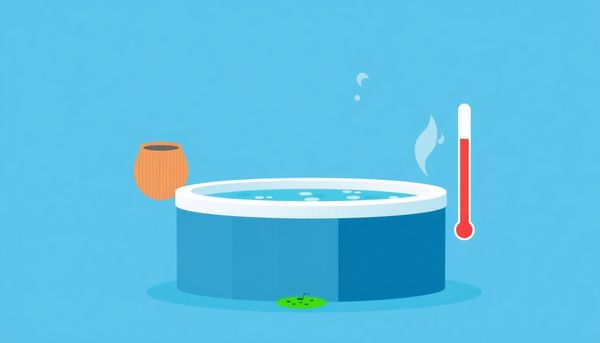Hot Tub Ownership: Understanding Costs and Energy Efficiency
May 27th, 2024
May 27th, 2024
When contemplating the allure of a hot tub, many envision tranquil evenings soaking under the stars or leisurely afternoons with soothing jets easing away the day’s tensions. However, the dream of owning a personal oasis often comes with pragmatic considerations, chief among them the cost of operation. Before taking the plunge into hot tub ownership, it’s crucial to understand the financial commitment beyond the initial purchase.
In my own experience, the decision to install a hot tub was not taken lightly. The initial excitement was tempered by questions of ongoing expenses. Energy bills, maintenance, and water treatment quickly became part of the equation. For instance, a friend who owns a hot tub shared that her electricity bill increased by about $30 to $50 monthly, a common range depending on usage and local utility rates. This is merely the tip of the iceberg, as regular water changes and cleaning products introduce additional costs.
Moreover, the expense varies with climate and location. In colder regions, maintaining a consistent water temperature might demand more energy, thus increasing utility costs. Owners might also need to consider investing in a quality cover to retain heat efficiently. By understanding these aspects, potential hot tub owners can manage and possibly mitigate the ongoing costs, ensuring their investment remains a source of joy rather than a financial burden.

Owning a hot tub can be a blissful escape, but it shouldn't lead to a financial headache. It's all about being smart with your choices to keep those costs in check. First, consider timing. Electricity often costs less during off-peak hours, typically late at night or early in the morning. This means heating your hot tub overnight can lead to significant savings on your energy bill. If your hot tub is equipped with a circuit timer, set it to take advantage of these lower rates.
Next, don't underestimate the power of a quality cover. It’s the unsung hero of hot tub efficiency, reducing heat loss and evaporation. A one-time investment in a durable cover pays for itself by cutting down on heating and water refill costs. For extra insulation, slip a thermal blanket under the cover—especially in winter. This added layer traps heat and can even harness solar energy if your hot tub is outdoors, providing a warm soak without the extra cost.
For those with outdoor spas, a little landscaping goes a long way. A windbreak created using shrubs or decorative screens can prevent the wind from cooling the water and increasing evaporation. This means your heater works less, saving you energy.
Moreover, regular maintenance is non-negotiable. Clean filters and hot tub components not only enhance performance but also extend the life of your spa, preventing costly repairs. By closing the air jets when not in use, you maintain water temperature, easing the burden on your heater.
Finally, reassess your hot tub's temperature settings. Lowering the temperature just a bit can yield noticeable savings without sacrificing comfort. Through these thoughtful adjustments, you can bask in your hot tub’s warmth without the worry of escalating costs.
Finding the right balance between relaxation and energy efficiency in managing a hot tub can feel like solving a puzzle. One significant piece is optimizing the heating schedule. Many utility providers offer lower electricity rates during off-peak hours, typically late at night or early morning. Heating your hot tub during these times can noticeably trim your monthly bill.
Consider this: I once helped a friend set up a schedule that heated her spa at 3 a.m. daily. Not only did this shift result in noticeable savings, but it also meant her hot tub was perfectly warm for a sunrise soak—a lovely bonus!
For those equipped with a smart thermostat or a timer, setting it to heat during off-peak hours can automate these savings, sparing you from remembering to adjust it manually. Even without a high-tech setup, manually adjusting the thermostat to lower temperatures when not in use can reduce the energy needed to maintain the water's warmth.
Moreover, frequently using a thermal blanket alongside a well-fitted cover can effectively retain heat, lessening the workload on the heater. This simple step can reduce the frequency of heating cycles required, ensuring your hot tub stays inviting without draining your wallet. In the long run, these adjustments can lead to significant savings and a more sustainable hot tub experience.
On a crisp autumn evening, I found myself sinking into the warm waters of my hot tub, a moment of pure relaxation. But beneath this tranquil scene lies the unassuming hero of cost efficiency: insulation. Proper insulation is not merely a luxury—it's a necessity for keeping those utility bills in check.
When we talk about insulation, think beyond the obvious. It’s not just about wrapping your hot tub in a puffy jacket but diving deeper into the structure itself. High-quality foam insulation within the hot tub cabinet acts as a barrier, preventing heat from sneaking away. This means your heater doesn’t have to work overtime, saving you money in the long run. If your hot tub resembles a vintage relic more than a modern marvel, consider an insulation upgrade. Many energy-efficient hot tubs now come with full-foam insulation as standard, significantly reducing heat loss.
Moreover, take a cue from those chilly winter nights and consider additional thermal insulation. A simple investment in a floating thermal blanket can work wonders. These blankets lie on the water’s surface, offering an extra layer of protection and keeping water warm even during the coldest nights. They’re like cozy duvets for your spa, ensuring you get to enjoy those soothing soaks without a shocking energy bill.
Incorporating effective insulation is not just an option; it's a necessity for anyone looking to enjoy their hot tub without the financial guilt. By fortifying your hot tub against heat loss, you can relax knowing you’ve made a savvy choice for both comfort and cost-efficiency.
Regular maintenance doesn’t just keep your hot tub inviting; it also saves you money in the long run. Consider it an investment in your spa's longevity and your wallet’s health. Let me share a little secret from my early hot tub days: I once neglected the cleaning routine, and it cost me more than a few cozy soaks. Over time, the water grew cloudy, the filters struggled, and the unexpected repair bills piled up. Simply put, neglecting cleanliness can cut into your budget, turning a relaxing experience into a costly ordeal.
Start with the basics: weekly testing and balancing of your water's pH and sanitizer levels. It’s a small task that prevents larger issues from bubbling up. Also, regular filter cleaning is a must. A quick spray with a garden hose often does the trick, but occasionally, a deeper clean with a dedicated filter cleaner is necessary. This ensures that your filtration system functions efficiently, avoiding overstrain and potential damage.
Don’t forget the cover; it needs attention too. A clean cover helps keep debris out and reduces strain on the filters. Simply wipe it down with mild soap and water. Treat each cleaning session as a spa day for your hot tub—it’s a simple routine that lets you enjoy every soak without worry. Maintaining cleanliness regularly isn’t just about hygiene; it’s about ensuring your hot tub remains a cost-effective pleasure for years to come.

Owning a hot tub brings relaxation right to your doorstep, but it doesn't have to come with a hefty electric bill. By focusing on energy efficiency, you can maintain that blissful soak without burning through your wallet. Start by investing in a high-quality cover; it’s a simple addition that can cut costs dramatically. A cover not only reduces evaporation but also acts as insulation, keeping the heat where it belongs. I remember when I first got my hot tub, slipping on a sturdy cover shaved a noticeable amount off my monthly expenses.
Another often-overlooked trick is adjusting your heating schedule. Electricity rates tend to dip during off-peak times, usually late at night or early in the morning. By setting your hot tub’s thermostat to heat during these hours, you can enjoy a warm soak while saving money. I used to set mine to heat up at sunrise, so it was perfectly ready for a morning dip—a peaceful way to start the day without worrying about the cost.
Don’t forget about the wind. It might seem harmless, but breezes can cool your hot tub’s water quickly, forcing the heater to work harder. Consider planting some shrubs or installing a windbreak around your tub area to keep the elements at bay. Not only does this help with energy efficiency, but it can also enhance the privacy of your outdoor spa retreat. Embrace these strategies to maximize efficiency, and you'll relish your hot tub without the financial headache.
Balancing relaxation and cost efficiency is key when it comes to hot tub ownership. Tweaking your heating schedule can significantly cut down on energy bills. For instance, taking advantage of off-peak electricity rates is a smart strategy. Many utility companies offer reduced rates during nighttime or early morning hours when overall demand is lower. By programming your hot tub to heat during these times, you can enjoy the warmth without straining your wallet.
In addition, think about the frequency and timing of your soaks. If you only use your hot tub on weekends, there’s no need to keep it at a high temperature all week. Lower the thermostat when it's not in use and only crank it up a few hours before you plan to soak. You'd be surprised how this simple adjustment can lead to significant savings.
A friend once shared her habit of planning weekly hot tub sessions and sticking to them, which helped her maintain a lower, steady temperature for most of the week. This not only kept her energy costs manageable but also turned those hot tub dips into much-anticipated events.
Lastly, consider layering your insulation tactics. Alongside a sturdy cover, using a thermal blanket can help maintain your hot tub’s warmth by reducing heat loss. These measures ensure that your heater isn’t working overtime, which translates into further savings. Combining these methods makes for an optimized heating schedule, keeping your relaxation both affordable and sustainable.
The thought of cutting down on those pesky energy costs while keeping your hot tub experience blissful might seem daunting, but fear not. An effective hot tub cover can be your first line of defense. A quality cover acts much like a thick winter coat, trapping in warmth and preventing that precious heat from escaping into the chilly night air. It seems straightforward, but the savings it brings can be impressive, reducing your heating costs significantly.
Many overlook the humble hot tub cover, dismissing it as just another accessory. Yet, investing in a well-insulated cover is like stuffing extra cash back in your wallet. Not only does it prevent heat loss, but it also minimizes water evaporation, meaning you won’t find yourself constantly topping off your tub or using excessive amounts of chemicals. Consider this: every time you lift that cover, you’re effectively keeping hundreds of dollars from evaporating into thin air over time.
But let's not stop there. If your cover is sagging or tearing, it might be time for a replacement. A worn-out cover can be counterproductive, allowing heat to seep out and running up your electricity bill. Take a moment to inspect it every few months—small maintenance checks can go a long way. By ensuring your hot tub stays warm and cozy, you’ll enjoy soaking without the stress of soaring utility bills, making every dip feel like a smart investment.
Balmy evenings under the stars become even more magical when accompanied by the gentle hum of a hot tub. But beneath the bubbles, managing wind and water loss is crucial to keeping operational costs in check. Have you ever noticed how quickly water levels can drop when your spa is uncovered on a breezy day? It’s not just annoying; it’s expensive.
First, consider the sneaky culprit: wind. An open hot tub on a windy day accelerates evaporation, causing the heater to work overtime to maintain your desired temperature. Installing a windbreak, whether it's a stylish screen or a row of hardy plants, can significantly cut down on lost heat. This simple barrier doesn’t just keep your water warm—it adds a touch of privacy and elegance to your backyard oasis.
Then there's water loss from splashing, which may seem trivial but adds up over time. Encourage gentle soaks rather than wild water antics to preserve precious gallons. If you do spot a drop in water levels, it’s wise to inspect for leaks. Even a tiny, persistent drip can become a substantial drain on your resources.
Remember, effective management of wind and water loss is more than just practical; it’s an art that combines utility with aesthetic. By taking these steps, you maintain the balance between enjoying your investment and managing its costs, allowing you to soak without a hint of stress.
Slipping into a hot tub after a long day is one of life's small luxuries, but keeping that tub clean is essential to savor every moment without worry. Regular maintenance isn't just about aesthetics; it's crucial for both your health and your wallet. Let’s break down how a clean hot tub can prevent costs from bubbling over.
Every few months, it's wise to drain and scrub your tub thoroughly. This practice helps avoid buildup of oils and debris that could compromise the filter or damage the tub's surface. Picture this: a friend of mine ignored this routine check, and ended up with a clogged filter and sky-high repair bills. Learning from her oversight, I now schedule quarterly cleanings like clockwork.
Beyond the deep clean, weekly upkeep matters too. Use a specialized cleaner for the shell and vinly covers, and pay attention to your filters. You’d be surprised how long a simple spray with a hose can prolong their life. And when they seem beyond redemption, don’t hesitate—replace them. A fresh filter equals cleaner water and less strain on your hot tub’s mechanics.
Finally, keep an eye out for unexpected leaks or issues. A small, unnoticed drip can lead to major repairs if left unchecked. By maintaining your hot tub diligently, you’re not just preserving a place of relaxation; you’re ensuring it remains a cost-effective retreat. So, here’s to cleaner soaks, fewer headaches, and a hot tub that’s always ready when you are.
A significant leap towards reducing hot tub operational costs involves upgrading to energy-efficient models. Think of it as trading in your old, fuel-guzzling car for a sleek hybrid. Hot tubs have evolved, with newer models boasting impressive energy-saving features. These updated versions often come with advanced insulation, efficient heating systems, and smarter technology that keeps costs down without sacrificing comfort.
Consider my neighbor, Sarah, who recently made the switch. Her old hot tub was a notorious energy hog, leading to steep monthly bills. After exploring options, she invested in a model with a high-efficiency pump and a programmable thermostat. The result? Her energy consumption dropped by nearly 50%, turning her hot tub from a luxury burden into a manageable indulgence.
Moreover, these modern hot tubs often include eco-friendly modes, allowing you to maintain functionality while conserving energy. Some models even incorporate solar panels or heat recovery systems, taking advantage of renewable energy sources. The initial expense might be higher, but the long-term savings and reduced environmental impact make it a worthy investment.
Before making the leap, evaluate the features that matter most. Whether it's superior insulation or digital controls, ensure your choice aligns with your lifestyle and budget. In the end, an energy-efficient hot tub not only saves money but also enhances your soaking experience, making sustainability a part of your everyday relaxation routine.

Imagine you're cozied up in your hot tub, savoring the warmth. Then, that pesky electric bill arrives, reminding you of reality. One easy way to keep those costs down is by incorporating a thermal blanket into your hot tub routine.
Thermal blankets are like an extra sweater for your tub, snugly trapping the heat. They rest directly on the water’s surface beneath the cover, minimizing heat loss and reducing evaporation. This means your heater works less, keeping your energy consumption—and bills—lower. They’re a small investment with a significant payoff. Most thermal blankets are dual-purpose, functioning as solar blankets to harness the sun’s natural energy during the day. This can be particularly beneficial if your tub sits under the open sky, allowing the sun to do part of the heating work for free.
In colder months, an extra layer of insulation is invaluable. A thermal blanket helps maintain water temperature, preventing freezing and eliminating the need for constant reheating. This not only prolongs the life of your equipment but also keeps those energy bills in check.
So next time you're soaking away the stress, you won't need to worry about the cost of comfort. A thermal blanket is your tub’s best friend, keeping the heat where it belongs and easing the strain on both your tub and your wallet.
Everyone loves a good soak in the hot tub, but no one enjoys the surprise of a hefty electric bill. To keep those costs in check, it's all about optimizing energy efficiency. Consider this: my friend Dave swore by his nighttime heating strategy. By setting his hot tub’s heater to work during off-peak hours, he trimmed his monthly electric costs significantly. Just a small tweak with the timer can make a noticeable difference.
Another simple yet effective method is investing in a high-quality hot tub cover. A cover not only traps heat but also prevents water and chemicals from evaporating. Think of it as wrapping your tub in a cozy, energy-saving blanket. Dave found his cover paid for itself within months through reduced heating and chemical costs.
Adding a thermal blanket is another layer of protection. It sits directly on the water, acting as a barrier against heat loss and evaporation. Many thermal blankets also harness solar energy, which can further cut down on heating expenses. Dave’s thermal blanket even doubled as a poolside conversation starter, showcasing its dual functionality.
Implementing these strategies doesn't just conserve energy; it makes every soak more sustainable. By adjusting heating schedules, utilizing covers, and embracing thermal insulation, you turn your hot tub into a sleek, efficient relaxation station without sacrificing comfort or style.
Sitting by my own hot tub during a chilly evening, I realized the secret to a consistently warm soak wasn't just about cranking up the heater. It's about making your hot tub work smarter, not harder. One of the simplest yet most effective methods is to invest in a high-quality thermal cover. This isn't just any cover, but one that fits snugly, preventing heat from escaping. I once underestimated my old cover's effectiveness until I swapped it for a new one and noticed a delightful dip in my energy bill.
Beyond covers, consider the power of a thermal blanket. It floats directly on the water, adding an extra layer of insulation. On particularly frosty nights, this small addition can significantly reduce heat loss, as well as maintain chemical balance by minimizing evaporation. My friend Lucy swears by a solar blanket version, which cleverly harnesses the sun’s energy during daytime to warm up her outdoor spa.
Creating a windbreak around your hot tub is another clever hack. Gentle landscaping with hedges or decorative screens can shield your tub from chilly gusts. I did this with a line of bamboo, and the difference was noticeable—my heater didn’t kick in as often. Each of these measures, from ensuring a proper cover to crafting a natural barrier, can enhance heat retention, offering both comfort and cost efficiency.
Evaporation might sound like a harmless science term from high school, but when it comes to your hot tub, it’s the sneaky culprit behind unnecessarily high bills. Take a moment to think about it: every little bit of water that escapes needs to be replaced, and what’s more, it took energy to heat that water in the first place. The loss isn’t just about water, but also the energy used to warm it—double trouble for your wallet.
Investing in a high-quality hot tub cover offers a simple yet effective solution. These covers act like a cozy, protective blanket that traps in heat and prevents water from escaping into thin air. If you already have a cover, ensure it's in tip-top shape—no tears or worn-out patches that can undermine its effectiveness. I once had an old cover with a tiny rip, and it was like leaving a window open in winter. Fixing or replacing it made a noticeable difference in my monthly bills.
But let’s not stop there. A thermal blanket, snugly placed right on the water’s surface under the cover, adds an extra layer of protection. This simple addition can slash evaporation rates significantly and keep those heating costs in check. It's like adding an extra layer of insulation to your attic—small cost, huge payoff. Next time you’re bundled up in your warm, inviting hot tub, you’ll know you’re doing so with both comfort and savings in mind.

Stumbling upon unexpected hiccups in hot tub ownership can be as frustrating as a lukewarm soak. Fear not, seasoned hot tubbers know the tricks to tackle these common issues without a hitch. Take water clarity, for instance. One morning, you might notice your once-crystal-clear water looks more like murky soup. The culprit? Likely an imbalance in chemical levels. To quickly restore balance, test the water for pH and alkalinity regularly, and adjust as necessary with the proper chemicals. A handy tip is to keep a log of your chemical usage and water tests; it can prevent imbalances before they start.
Then there's the ever-annoying error code flashing on the control panel. It's akin to a car's check engine light—vague but ominous. Many hot tub owners have found that a simple power cycle can clear minor glitches. If not, consult your manual or reach out to the manufacturer for guidance. Sometimes, it’s as simple as a loose connection or a blocked filter. Speaking of filters, they are the unsung heroes of hot tub maintenance. Clogged filters not only lead to error codes but can also strain the pump. Make it a monthly ritual to rinse them thoroughly—more often if you use the tub frequently.
Finally, consider energy consumption. While leaving the hot tub running might sound convenient, it's not always cost-effective. Adjust the temperature settings to suit your usage patterns, and ensure your cover is snugly fitted to keep the heat in. Tackling these common issues head-on will help ensure your hot tub remains a source of relaxation rather than a source of stress.
Energy bills can be sneaky, especially when your favorite relaxation spot is a hot tub. A few mindful tweaks, however, can help keep your costs under control. Let's start with timing. Many utility companies offer lower rates during off-peak hours, typically late at night or early in the morning. By scheduling your hot tub's heater to run during these times, you can enjoy significant savings without sacrificing those warm, comforting soaks.
Next up, insulation is key. A high-quality hot tub cover is a non-negotiable investment. Not only does it prevent heat (and money) from escaping, but it also keeps debris out, reducing the need for frequent cleaning. If your cover is gathering dust, it's time to dust it off and put it to work. Should your cover show signs of wear, consider replacing it to ensure optimal performance.
Adding a thermal blanket beneath your cover is another effective strategy. This extra layer acts like a cozy sweater, helping to trap heat and reduce energy consumption. Many of these blankets double as solar covers, soaking up the sun's rays to naturally warm your water.
Outdoor placement adds another layer of complexity. Wind, surprisingly enough, can cool the water rapidly, making your heater work overtime. Planting small shrubs or installing a decorative screen can act as a windbreak, keeping the temperature stable and your energy costs down. By embracing these practical changes, you'll not only enjoy your hot tub more but also without the shock of high energy bills.
In the quest to reduce hot tub operating costs, one often overlooked yet essential strategy is enhancing its insulation. Consider it like wrapping a cozy blanket around your beloved spa. Insulation is not just about warmth; it’s a savvy way to conserve energy and trim down that pesky electric bill.
Take my friend Jake, for instance. He noticed a significant dip in his electricity expenses after deciding to reinforce his hot tub's insulation. Initially skeptical, he invested in high-quality insulating foam and placed it around the cabinet of his outdoor spa. This simple addition worked wonders, keeping the heat locked in and the cold at bay. His heater didn’t have to work overtime anymore, which not only saved money but also prolonged the life of the equipment.
Moreover, you might want to explore adding foam panels or an insulating blanket beneath the hot tub itself. By insulating the bottom, you prevent heat loss through the ground, especially in colder months. This layer acts as a barrier, keeping the warmth where it belongs—inside the tub, where you can enjoy it.
Ultimately, enhancing your hot tub's insulation is a straightforward yet effective method to cut costs. It's an investment in both comfort and efficiency, allowing you to indulge in those soothing soaks without the financial guilt trip. So, when the temperature drops, and the wind howls, rest easy knowing your hot tub is snug and energy-smart.
Keeping a hot tub clean and running efficiently isn't just about preserving its aesthetic appeal; it's a smart strategy for managing costs. A neglected hot tub can lead to higher energy bills and unexpected repairs. Take the cover, for instance. It's not just a lid; it's your first line of defense against evaporation and heat loss. Investing in a high-quality cover and ensuring it fits snugly reduces the workload on your heater, saving you a significant amount of energy in the long run.
Equally important is maintaining the tub's filtration system. A clogged filter not only strains the system but can also escalate your electricity usage. Regular cleaning of the filter, perhaps with a hose or a specialized cleaner, keeps everything running smoothly. When the filter reaches the end of its life, replace it promptly to prevent inefficiencies.
And let's talk about water chemistry. Testing your water regularly and adjusting the chemical balance prevents not only skin irritations but also potential damage to the tub's components. A well-maintained water balance means the heater and pump don’t have to work overtime, thus extending their lifespan.
Lastly, consider the placement of your hot tub. Sheltering it from the wind with barriers or hedges minimizes heat loss, and keeping it out of direct sunlight reduces unnecessary water evaporation. In the end, these small, consistent efforts can lead to substantial savings, ensuring that your hot tub remains a luxurious retreat rather than a financial burden.

This article provided insights into maintaining your pool. Start your pool care journey today!
Want to become a pool maintenance expert? Our free Pool School course covers everything you need to know about pool care. From basic maintenance to advanced troubleshooting, you'll learn how to:
Join over 10,000 pool owners who have already transformed their pool care routine. Get started with our free Pool School course today!